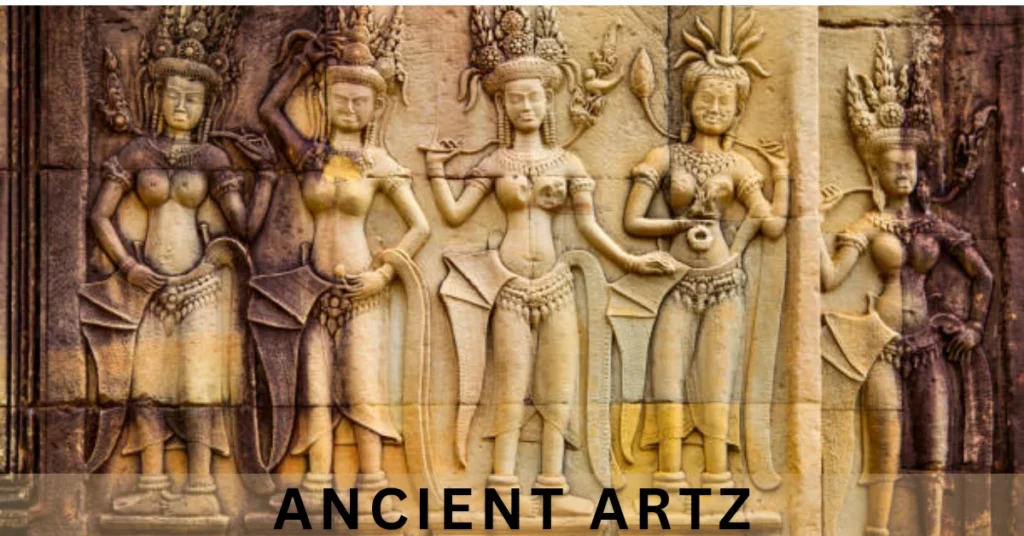Introduction: The Eternal Power of Art
Art has always been more than decoration—it’s a powerful medium that connects humanity across time and space. Ancient Artz, with its vivid colors, intricate forms, and spiritual depth, tells the stories of our ancestors. These creations are not just relics; they’re expressions of belief, struggle, triumph, and identity.
From temple murals to carved stone relics, every artifact carries a legacy. Let’s journey into the past to explore how ancient creativity still inspires and shapes our modern world.
The History and Evolution of Ancient Artz
Origins in Cave Paintings
- Early humans expressed experiences using symbols and pigments on cave walls.
- These paintings offered insights into daily life, rituals, and survival strategies.
Art in Early Civilizations
- Egypt: Used hieroglyphs and murals to depict life, death, and the divine.
- Mesopotamia: Developed relief sculptures that captured societal events and myths.
- Greece: Transitioned from abstraction to realism, showcasing human emotion and form in sculptures.
- Asia: Introduced spiritual depth through ink wash paintings (China) and vibrant frescoes (India).
Cross-Cultural Influence
- Trade and migration led to the exchange of styles and techniques.
- Artistic traditions were shared and adapted, leading to blended aesthetics across continents.
The Power of Creativity in Ancient Civilizations
Creativity in ancient societies was more than artistic—it was foundational to their identities.
- Storytelling: Myths, legends, and history were visualized through art.
- Communication: Art bridged language barriers, communicating beliefs and customs.
- Innovation: Architecture like the Pyramids or the Parthenon reflected artistic and engineering mastery.
- Cultural Legacy: Artisans used local materials to craft pieces that endured for generations.
Each creation wasn’t just decorative—it was meaningful and deeply rooted in the civilization’s worldview.
The Role of Art in Diverse Cultures
Egypt & Mesoamerica
- Egypt: Murals and tomb art illustrated journeys into the afterlife.
- Mayan Civilization: Art depicted cosmic events and mythological deities.
Asia
- China: Calligraphy was both an art and a spiritual meditation.
- India: Temple frescoes told epic stories from sacred texts.
Africa
- Tribal masks symbolized ancestral spirits and were central to ceremonial life.
Indigenous Australia
- Dot paintings expressed Dreamtime stories—spiritual narratives passed through generations.
Europe & Japan
- Europe: From Roman mosaics to Renaissance masterpieces, art evolved to reflect realism and humanism.
- Japan: Ukiyo-e prints captured everyday beauty and philosophical depth.
Across the world, ancient art revealed the soul of each culture, leaving legacies that continue to inspire.
Techniques and Mediums in Ancient Artz
Ancient artists used natural materials and ingenious techniques to create enduring masterpieces.
Common Techniques
- Fresco Painting: Applied pigment to wet plaster for vibrant wall art.
- Relief Sculpting: Carved images into stone to create raised or sunken designs.
- Weaving & Textiles: Embroidered or dyed cloth to narrate stories and cultural motifs.
Popular Mediums
- Natural Pigments: Made from minerals, plants, and insects.
- Stone & Wood: Used for sculptures, totems, and tools.
- Pottery & Ceramics: Functional items adorned with symbols and artistic motifs.
Each piece reflected technical prowess and deep cultural significance.
How Ancient Art Influences Modern Society
Even in today’s digital age, ancient art continues to influence how we express ourselves.
Design & Fashion
- Ancient motifs frequently appear in:
- Fashion patterns
- Jewelry designs
- Home décor items
Architecture
- Classical elements like columns and arches inspire contemporary building styles.
- Public monuments and museums often mimic ancient structures.
Social Movements & Identity
- Ancient symbols are reinterpreted to express modern values, identity, and resistance.
- Street art and digital collages often reference historical art forms.
Technology & Innovation
- VR experiences recreate ancient ruins for education and tourism.
- 3D printing replicates ancient artifacts for preservation and exhibition.
Ancient Artz serves as a timeless wellspring for modern creativity and cultural commentary.
Conclusion: Embracing Creativity Through the Lens of the Past
Ancient Artz is more than a glimpse into history—it’s an invitation to awaken the artist within you.
By studying the artistic legacies of ancient cultures, we gain a deeper appreciation for their creativity and resilience. These works remind us that art is not bound by time; it’s a language that continues to evolve and inspire.
Let ancient creativity guide your own expression. Whether through painting, writing, sculpting, or digital design, tap into this rich heritage to craft something uniquely yours. Embrace the past not just as history, but as fuel for your own creative journey.
ALSO READ: Hitlmila: Framework to Unlocking Agile Innovation for Businesses
FAQs
What is Ancient Artz?
Ancient Artz refers to the creative works produced by early civilizations, including cave paintings, sculptures, pottery, murals, and textiles. These artworks offer insights into ancient beliefs, values, and societies.
Why is ancient art still relevant today?
Ancient art continues to inspire modern design, architecture, fashion, and storytelling. It provides cultural context and a sense of continuity across generations.
What materials did ancient artists commonly use?
They used natural materials like minerals for pigments, stone and wood for carvings, and plants or insects for dyes. These materials were often locally sourced and sustainable.
How did ancient art influence modern architecture?
Many modern buildings incorporate classical features like columns, arches, and symmetry—elements originally used in ancient Greek and Roman architecture.
Can I learn artistic techniques from ancient cultures?
Yes! Many art schools and online courses explore ancient methods like fresco painting, calligraphy, or pottery, allowing you to integrate historical techniques into your own practice.






